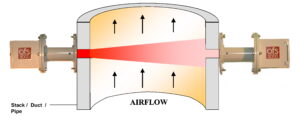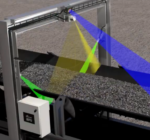Demanding monitoring environment at cement industries
Process control and emissions monitoring at a cement plant can be a challenge due to high dust levels and corrosive gases. OPSIS offers gas analysis systems that can handle these environments and that have high accuracy, short response times, and long maintenance intervals.
MANY APPLICATION AREAS
OPSIS monitoring systems are very well suited for monitoring gas concentrations in the dusty and corrosive environments in the cement industry. A large number of installations confirms this.
The OPSIS systems are most often used to monitor emissions to the ambient air. There are often authority requirements that the emissions must be monitored and reported so that they can be compared with established emission limits. Here, the concentrations of all gas types may need to be monitored together with dust, flue gas flow, etc.
The OPSIS monitoring systems can also be used to monitor and optimise the combustion process by measuring CO and O2 concentrations in the hot raw gas directly after the furnaces. Signals to control the raw gas cleaning can also be retrieved from the OPSIS monitoring systems. More information about this can be found on the raw gas monitoring page. See our application page on mercury monitoring for more information about Hg and total Hg monitoring.
CERTIFIED SYSTEMS WITH HIGH PERFORMANCE
The OPSIS monitoring systems are based on gas analysers that have short response times, are accurate, and require minimal maintenance. The monitoring takes place contact-free along light beams where gas molecules can absorb parts of the light. When monitoring emissions, light beams are either sent through the gas ducts that lead to the stacks, or some of the flue gases are led into measurement cells through which the light is sent. The light is captured and led via optical fibres to the analyser which measures the absorption and calculates the gas concentrations.
A single analyser can measure several types of gases along several light paths. It provides a very cost-effective monitoring system. The concentrations of all relevant types of gases can be monitored, for example NOX, SO2, CO, CO2, H2O, HCl, HF, NH3, CH4, Hg, and total mercury (THg).
GAS ANALYSIS WITH OPSIS
There are multiple reasons for choosing OPSIS as supplier of systems for gas analysis. Among the key benefits of the methods and solutions offered by OPSIS are:
Link is for a variety of short informational videos found on the OPSIS website : OPSIS Play
Contact us for more information

Sales is restricted to the province of Quebec and the Maritime Provinces.
Optical Scientific, Inc. (OSI) optical scintillation anemometry offers a non-intrusive, path-integrated method for measuring airflow and emissions in large ducts and open pot room environments. It is ideally suited for high-temperature, dusty, and chemically aggressive conditions. OSI systems deliver real-time data with high resolution, minimal signal degradation, and low maintenance requirements—making them a dependable choice for continuous ventilation and emissions monitoring in very difficult and demanding environments.
For more information refer to our product page: Optical Scintillation

BinMaster 3D Level Scanner for Silo Inventory
Accurate inventory measurement of powder ensures efficient process control, optimize raw material usage, and maintain consistent production rates.
The BinMaster 3D Level Scanner is specifically designed to address these challenges by using low-frequency acoustic mapping technology to generate a precise three-dimensional profile of the material surface inside the silo. Unlike single-point level sensors, which only provide a snapshot of the material height at one location, the 3D scanner captures multiple measurement points across the entire surface. This allows it to calculate not only the highest, lowest, and average levels, but also a more accurate estimate of the total volume of powder in storage.
Key features and benefits of the BinMaster 3D system include:
• True volume-based inventory measurement – essential for bulk material management and procurement planning.
• Reliable performance in dusty, noisy, and high-temperature environments
• Detection of surface irregularities and cone-down/cone-up conditions,
• Non-contact technology that minimizes maintenance and operational disruptions.
The BinMaster MVL system integrates two or more 3D sensors and is designed for large storage silos containing bulk solids. It combines multiple 3D level sensors strategically mounted on a single silo to map material surfaces with complex topography, such as uneven filling, cone-up or cone-down patterns, and sidewall buildup. By aggregating data from each sensor, the MVL system provides a highly accurate calculation of volume and mass in very wide storage silos.
For more product details and videos : BinMaster 3D

Non-contact Volume flow, Material speed, Bulk & belt position
The iBelt system by INDURAD, enhances conveyor operations with high-speed 2D radar scanning for accurate volume flow measurement, capturing cross-sectional views and providing height and material distribution insights. Its radar-based, contactless speed measurement delivers 99% accuracy, optimizing belt speeds and preventing slippage without needing recalibration. The iBelt Misalignment feature detects belt misalignment, reducing wear, energy consumption, and spillage risks. Additionally, its freeboard measurement ensures optimal material positioning, minimizing wear and enhancing belt longevity and safety. Overall, iBelt ensures efficient, safe, and cost-effective material handling.
For detailed information as well as informative videos please click on the link below:
Please contact us at controls@cancoppas.com or call us at the appropriate office should you require additional assistance.
Contact Us


